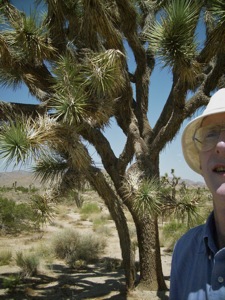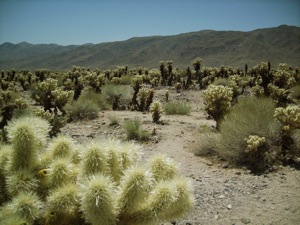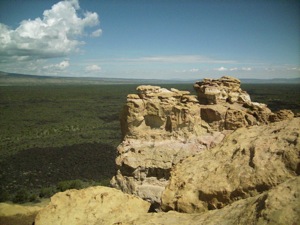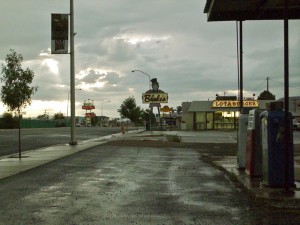I left Needles, that “miserable place,” early in the morning. It was hot already. I drove south on U.S. 95, through the hot, dry, bleak Colorado desert. This is a two-lane paved road that I would not want to drive during a rain storm; there are no culverts (not that I saw, anyway) and the road dips down to meet every dry wash.
Bleak as it was, the desert scenery was spectacular: stark, forbidding mountains rising up out of the sand plains studded with creosote bushes. After more than an hour of driving, I began to pass side streets, and I began to see small houses here and there in the desert. A sign told me when I reached the city limits of Twentynine Palms, population nearly thirty thousand.
I stopped at the visitor’s center for Joshua Tree National Park, and walked around the Oasis of Mara. It was disappointing: no open water (the water table subsided some years ago after seismic action in the nearby Pinto Mountains), and fewer than twenty nine palm trees. But there were Gambrel’s Quail hiding under the low mesquites, and a pair of Prairie Falcons perched in one of the palms.
From Twentynine Palms, I headed south through the park. The Joshua Trees that give the park its name made me smile. They almost look as if they might start talking to you.

The cholla cactus seem to have personalities, too. Even though you know the lightest touch would be enormously painful, they look almost as if they wanted you to cuddle them.

The tall, twisted octillo with its tiny leaves, the mesquite trees, the fan palms: all these amazing plants growing in a very unpromising environment. The birds are amazing too. I stopped at Cottonwood Springs, and even though it was the hottest part of the day, the birds were cheerful because of the seeping water. But the sun was too hot for me; I wanted to stay longer, but I was getting a heat headache, and drove on.
The rest of the drive merely took me deeper and deeper in the urban and suburban sprawl that stretches along the Pacific rim of California. I’m not really ready to stop, but here I am in El Cajon, just outside of San Diego, at the end of my 3,200 mile journey.


